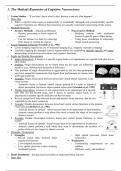1. The Methods Repertoire of Cognitive Neuroscience
1. Lesion Studies – “If you don’t know what it does, destroy it and see what happens”
o Basic Idea
When a specific brain region is purposefully or incidentally damaged, and consequentially specific
cognitive functions are affected, these functions are causally connected to processing in this region.
o Methods Overview
Invasive Methods – ethically problematic Non-invasive Methods
- Destroy processing in brain region of - Studying patients with incidental
interest lesions in specific parts of their brains
- Can for instance be done by removing - Using brain stimulation to temporally
brain tissue or cooling the region impair neural processing
o Lesion Mapping in Patients (Goodale et al., 1991)
Lesion mapping requires the use of structural imaging (e.g., magnetic resonance imaging)
Carefully mapping the damaged cortical regions allows for establishing spatially specific and causal
relationships between brain activations and cognitive functions
o Single and Double Dissociations
Single dissociation: A lesion to a specific region leads to an impairment in a specific task (but not in
other tasks)
Problem: Single dissociations my be found when the two tasks are differently
sensitive (e.g., different task demands or difficulty)
This problem of single dissociations is aggravated by the fact that participants
may have unspecific impairments that impair their performance in various tasks
with high sensitivity
Example: Single dissociation between dorsal and ventral stream functions in the
visual system
- Traumatic lesion in human ventral stream (patient D.F.) leads to impaired
object perception, but leaves object-guided action intact (Goodale et al., 1991)
Double dissociation: A lesion to one region leads to an impairment in a specific
task (but not the second task), and a lesion to another region leads to an
impairment in another specific task (but not the first task)
Reveals unequivocal links between lesion and putative brain function, that are not
explicable by the tasks’ sensitivity
Example: Double dissociation between dorsal and ventral stream functions in the primate
visual system (Mishkin et al., 1983)
- Artificial lesions in animals’ ventral stream leads to an impairment in discrimination
- Animals cannot perform a task where they need to match the shape of two targets to
obtain a reward
Example: Double dissociation between dorsal and ventral stream functions in visual
system
- Artificial lesions in animals’ dorsal stream leads to an impairment in localization
- Animals cannot perform a task where they need to discriminate the position of a
probe relative to two targets to obtain a reward
o Strengths / Weaknesses
Strengths - High spatial precision (when done
- Reveal causal links between brain invasively)
regions and function Weaknesses
- Low temporal precision - Confounding impairments are not
- Low spatial precision (when studying unlikely
incidental lesions) - Difficult, costly, and unethical
2. Brain stimulation – driving neural activation to understand brain function
o Basic Idea
, Invasive
When neurons
Methods communicate, they change their membrane Non-invasive
potentialsMethods
and eventually fire action
-potentials.
ElectricBystimulation
inducing electrical currentsininto neurons, we
of neurons - can eitherfast
Using push neurons magnetic
changing to fire more (or
fields
to beparticular
more excitable) or induce chaotic activations that prevent(Transcranial
brain regions coordinated firing.
Magnetic Stimulations)
o Methods
- InOverview
humans: Rarely possible for patients to stimulate neurons
with implanted electrodes (e.g., for - [Using transcranial direct (tDCS) or
informing epilepsy treatment) alternating (tACS) current stimulation
across the head to modulate activity]
o Invasive Brain Stimulation
Stimulating cortical regions allows for establishing causal relationships between neural function and
behaviour or phenomenology. What happens when the neurons are active?
Example: Electrical stimulation of human visual cortex
Stimulating face-preferring regions leads to the illusory perception of facial features
Stimulating colour-preferring regions leads to the illusory perception of colour patterns
o Transcranial Magnetic Stimulation
In TMS, we use a stimulation coil to produce fast changing magnetic fields over the scalp
These fast-changing magnetic fields reach brain regions close to the stimulated position.
As they do not reach very deep, we can selectively stimulate specific regions close to
scalp
Changing magnetic fields induce electric currents in neural tissue (Faraday’s principle)
Therefore, TMS pulses activate neurons by changing their membrane potentials. The
exact changes elicited by TMS application are not entirely understood and remain
under active investigation
Mueller et al., 2014: TMS changes neural activation immediately, but some effects
can carry over across shorter period of time (seconds)
- When applied repetitively, TMS can modulate neural activations across longer
time periods, as utilized in clinical applications (e.g., in tinnitus or depression)
We can “feel” these activations, when we stimulate particular regions with TMS
Stimulating early visual cortex leads to the experience of phosphenes
Stimulating motor cortex leads to muscle twitches in targeted body parts
TMS activation is mostly chaotic and not similar to patterns arising during perceptual
or cognitive processing
This chaotic activation therefore disrupts a regions’ responsiveness to external stimuli
We can thus use TMS to create “virtual lesions”, which however are not completely
and permanently abolishing activation
For some regions, by changing stimulation parameters, TMS can in principle also be used to
modulate neural activity to be enhanced
o Strengths / Weaknesses
Strengths - Underlying neural mechanisms often
- Reveals causal links between brain not well understood (unless invasive &
regions and function electrical)
- High temporal precision, reasonable - Widespread, remote effects possible
spatial precision (TMS) - Cannot specifically target all parts of
- Experimentation is easy and cheap the brain
Weaknesses
3. Electrophysiology – listening to brain waves
o Basic Idea
As neural communication is tightly linked to differences in electric potentials (membrane potentials),
measuring such potentials gives us a direct estimate of neural
activity!
o Neural Activity and Neural Firing
When neurons get excited above a specific threshold, action
potential are elicited (i.e., the neurons “fire”)
Neural firing is often seen as the major means of neural
communication (but as we shall see later, not the only one!)
To measure neural firing, it’s best to get as close as possible to a neuron




